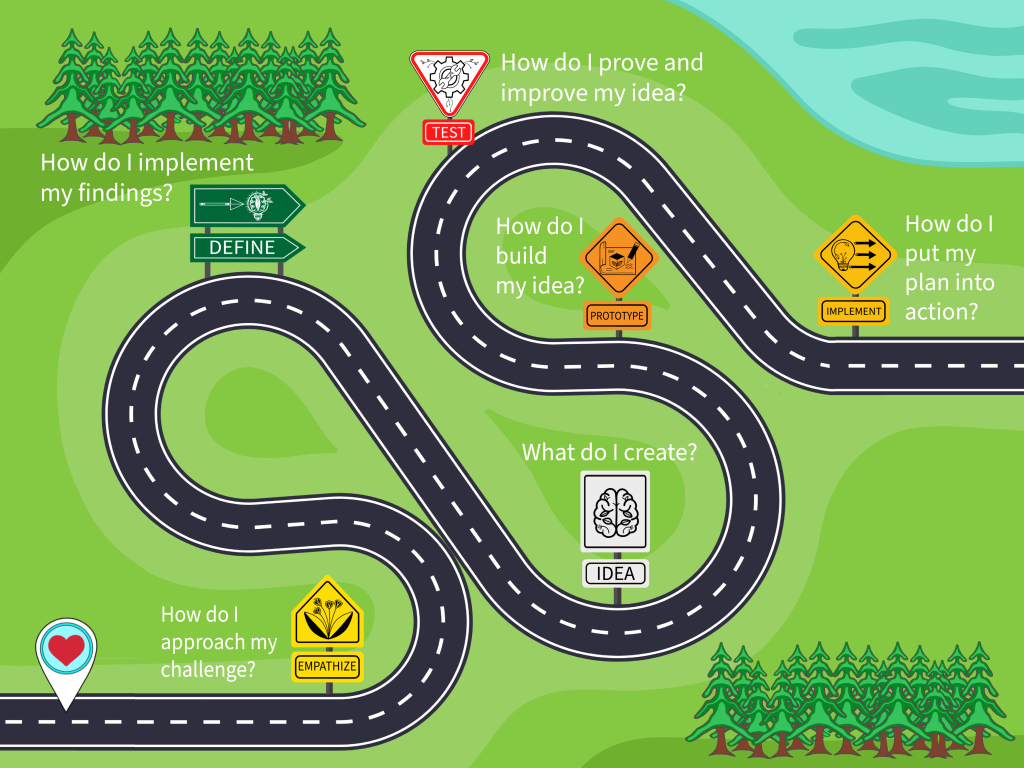Be Curious: Design Thinking

Design thinking is a human-centric approach to solving problems by creating new ideas. Design thinking is an iterative process in which we seek to understand the user, challenge assumptions, and redefine problems to identify alternative strategies and solutions that might not be instantly apparent with our initial understanding. At the same time, Design Thinking provides a solution-based approach to solving problems. It is a way of thinking and working and a collection of hands-on methods (Dam & Siang, 2020).
Design Thinking Process: Six Steps
Step 1: Empathize
Empathy: is the ability to understand and share the feelings of another person. Self-empathy involves having compassion for oneself. It is treating yourself with the same kindness and understanding that you would offer to a friend or loved one when they are going through a challenging or emotional experience.
The best way to solve a problem is first to understand the problem and your feelings about the problem. Empathizing enables you to learn about your needs, desires and goals. Empathy for yourself is essential to gathering insight into what is most important to you. Where a solution exists but the problem persists, we have an “empathy gap” – the gap between what people do and what people say they do. These gaps are the design opportunities.
Step 2: Define
Define: begin to highlight opportunities for change.
When defining a problem, we have to look beyond the apparent issue and think about the deeper root of the issue. The define stage is assessing the information gathered in the empathy phase to define the problem accurately. At the end of this phase, you should have a clearly defined problem statement which will guide you on your career path.
Step 3: Ideate
Ideate: brainstorm creative ideas that address the unmet needs.
Some people make the mistake of starting their design journey at the ideate stage. They may have a fantastic idea, but it does not solve their need. You clearly understand the needs and challenges that will drive your solution so you can develop workable ideas. This stage requires open-mindedness and can be facilitated through brainstorming activities. This might involve brainstorming different paths, strategies, and approaches to having a fulfilling career. Additionally, you can consider which of these ideas are feasible.
Step 4: Prototype
Prototype: The goal of this phase is to understand what components of your ideas work
Prototyping involves creating tangible or experiential representations of your ideas and strategies. This can take various forms:
- Experimental Changes: You might prototype by making small, temporary changes in your life to test out new habits, interests, or career paths. For example, if you’re considering a career change, you might take on a part-time internship or volunteer role in that field to see if it aligns with your aspirations.
- Visualization and Mind Mapping: Creating vision boards, mind maps, or visual representations of your life goals and plans can serve as prototypes. These visual aids help you clarify your thoughts and visualize the future you want to create.
- Role Playing and Scenario Testing: You can prototype by mentally or physically role-playing various life scenarios. Imagine yourself in different situations and assess how they align with your goals and values.
Step 5: Test
Test: ask yourself, ‘Does this solution solve the problem?’
Testing is an ongoing process that involves implementing changes and gathering feedback. You may have missed some key observations and need to return to the empathy stage. Alternatively, as time passes, the conditions that created the initial need for your solution may change, and you need to modify your approach or change the defined problem.
Testing will enable you to tweak and refine, discover anything you missed in the early stages of the design process, and find a successful solution.
Step 6: Implement
Implement: Put the vision into effect.
This is the most essential part of design thinking, but it is often forgotten. Design thinking does not free you from the actual design. It’s not magic. As impactful as design thinking can be, it only leads to actual change if the vision is executed.
The Design Thinking process is the framework used for this workshop to guide you through the career exploration process. The following modules will help you self-empathize, define your challenge, ideate, prototype, test some possible solutions, and implement your action plan.

Attributions
Design Thinking definition adapted from “5. Design Thinking” from Tools and Resources for Capstone Copyright © 2022 by Dr. Steve Marsh; Amanda McEachern Gaudet; and Mackenzie Collins is licensed under a Creative Commons Attribution-ShareAlike 4.0 International License, except where otherwise noted.
Design Thinking Process adapted from:
“1 What is Design Thinking” from Designing the Digital World Copyright © 2021 by NUI Galway is licensed under a Creative Commons Attribution 4.0 International License, except where otherwise noted.
“THE DIGITAL EXPERIENCE DESIGN PROCESS: FROM IDEATING TO IMPLEMENTATION” from Applying Digital Experience Design to Teaching and Learning Environments Copyright © by Irina Ghilic is licensed under a Creative Commons Attribution-NonCommercial-ShareAlike 4.0 International License, except where otherwise noted.

